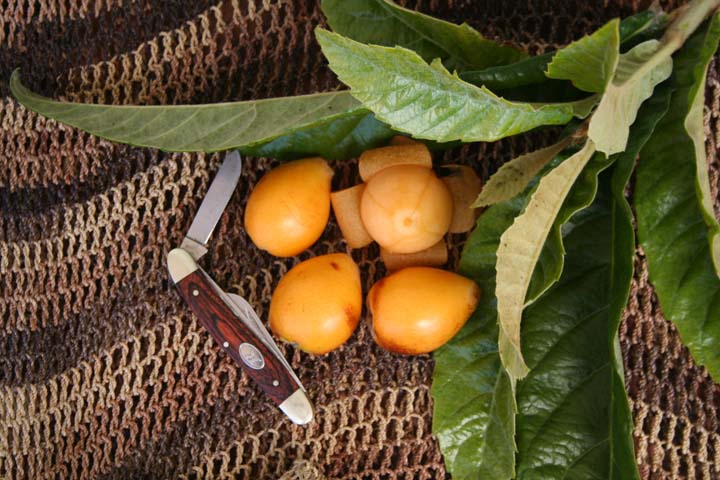Loquat

BY RICHARD J. CAMPBELL
FAIRCHILD TROPICAL BOTANIC GARDEN
As published in the Miami Herald
The loquat (Eriobotrya japonica) is a fruit of our South Florida childhood that has nearly disappeared – all due to a little fly no bigger than a pea. South Florida children would spend many a winter or spring afternoon up a loquat tree, harvesting and eating their way to contentment. For the homemaker the loquat also provided the makings for many a pie and preserve.

However, when the Caribbean fruit fly found its way to our shores back in the 1960s, the honeymoon was over. Now those clumps of sweet yellow fruit were host to the larvae of this most efficient fruit pest. Losses were great and a psychological barrier was built against the loquat. Nowadays the loquat is uncommon in our home gardens, but we would like to change this.
The loquat is native to Asia, but it is now widespread in the subtropical regions of the world. Chile, California and Israel all grow loquat for commercial sale and the fruit can be found seasonally on European grocery shelves. Loquat is a handsome landscape tree with thick, dark green leaves and a tight, upright canopy. The loquat can be grown throughout much of Florida, as it is highly cold tolerant.
As a signature tree in the landscape it is outstanding. The tree produces its fuzzy clusters of white flowers at the ends of the branches in the fall, and the fruit ripen during the winter and early spring time in South Florida. In the center of the state the trees are sometimes damaged by cold winters, but their recovery is rapid.
Fruit are produced in clusters of from 6 to more than 20 depending on the variety. Nearly all varieties have yellow or orange skin and the flesh color ranges from white to yellow or orange and an occasional pink. There are from one to several seeds within the fruit that separate readily from the flesh. The flavor is delicate and sophisticated, with a sweet/tart nature and floral bouquet.
Local nurseries carry several grafted varieties, including ‘Golden Nugget’, ‘Champagne’ and ‘Tanaka’. All three varieties will grow and fruit well here in South Florida.
‘Golden Nugget’ is precocious and forms a spreading canopy. The fruit are orange and plump, with one or two seeds. The flavor and production are excellent.
‘Champagne’ has a white to slight pink flesh. The fruit are elongated and have an exceptional flavor. Production is less than some of the other varieties, but the fruit are larger.
‘Tanaka’ is an orange fruit that produces a medium-sized plump fruit. The canopy is thin and upright and should be pruned to maintain size and fruiting. The flavor is excellent.
All varieties should be planted in the late spring and in the first years the branches should be tipped to encourage the formation of a bushy canopy. A canopy with many branches will bloom earlier than a canopy without pruning. The trees should be fertilized three times per year during the rainy season and in the home landscape the loquat will require no irrigation after establishment.
Loquat is in the apple and pear family and is susceptible to a serious disease called fire blight, which is a bacterium that enters the tree usually by way of the bloom. The disease is highly contagious to other loquat trees and can cause a sudden death of the tree. The disease is worse during cool wet weather, and is typically not a problem in extreme South Florida. To our north, in
Once the fruit have set they should be thinned to improve fruit size. To get maximum size, 40 to 50% of the fruit on the fruiting spike should be removed. One fruit should be left on each of the small branches of the fruiting spike, leaving 6 to 8 fruit. Thinning is done by hand and small trees are obviously easier to work with. This is another reason to maintain height control on your tree.
Once thinned the fruit cluster should be covered with an adequately large paper bag to protect the fruit from fruit fly. This must be done when the fruit are small. The bag is tied shut at the base of the fruiting cluster. When done properly there will be no opportunity for the fruit fly to lay its eggs in the fruit. The result will be larvae free loquats ready to eat.
The fruit are excellent out of hand and in the world of fruit pies the loquat is a force to be reckoned with. They make an excellent preserve and also freeze well. The trees are so productive that a single loquat will provide your family with a bounty each and every year.
The loquat was once an integral part of our home gardens, but with the entrance of the fruit fly this Florida favorite has been essentially lost. You can help to save this most deserving of fruit with just a little effort. So, let’s bring back the loquat and the Florida of old.
